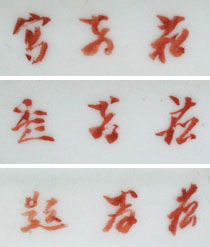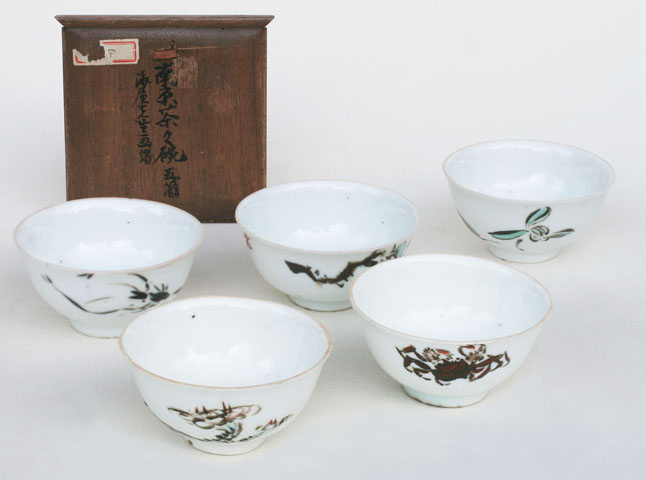Nanking
Set of 5 haku Nanking myôwan, white china, tea cups - Miscellenous verses, hurriedly written with a piece of kindlingSigned: Sûô sha
Seals:
Technique: White Nanking porcelain with coloured overglaze decorations Ø 8,1 x 4
Date: 1846, 7th month
Box: inscribed in 1846
Condition: some light hairlines in one cup, otherwise very good
Box inscription outside: 南京茶々碗五箇 海屋先生画讃
Set of 5 decorated white china, haku Nanking myôwan, tea cups:
Loose verses, further not known and written down with a hurried match.
瑞雲生這雪 This snow comes from benevolent clouds.
幽光在君子 Light settles upon the noble man.
老圃在仙果 The tree with the peaches of immortality is in the old orchard.
明月清溪來 The full moon meets the clear stream.
以善唾横行 Spread good things in all directions.
Kaioku was born as the second son of a martial arts teacher in the service of the Hachisuka domain in Awa Province. Although he was educated in the family tradition of martial arts, his weak constitution allowed him to follow Confucian studies, poetry and calligraphy.
After a brief training in Kanô painting he went to Nagasaki to study Nanga painting under the Zen-monk Hidaka Tetsuô (1791-1871). He chose to be a Confucian scholar for which he studied in several parts of Japan for many years of his life. For three years he studied calligraphy. He copied the style of the 9th century monk Kôbô Daishi permanently and mastered all the styles of calligraphy. After the death of Rai San'yô (1780-1832), Kaioku became the most celebrated bunjin artist in Kyoto.
In each of the editions of the Heian Jinbutsu shi from 1813 until 1852 Kaioku is mentioned twice as a poet as well as a calligrapher. In 1811 he settled in Kyoto where in 1828 he finally established the Suseidô, his own school.
Reference:
Rosenfield B.68
Berry & Morioka ’08 p. 287-88
Hempel p. 165
Roberts p. 64
Araki p. 1580 ff.
Price: ON REQUEST

